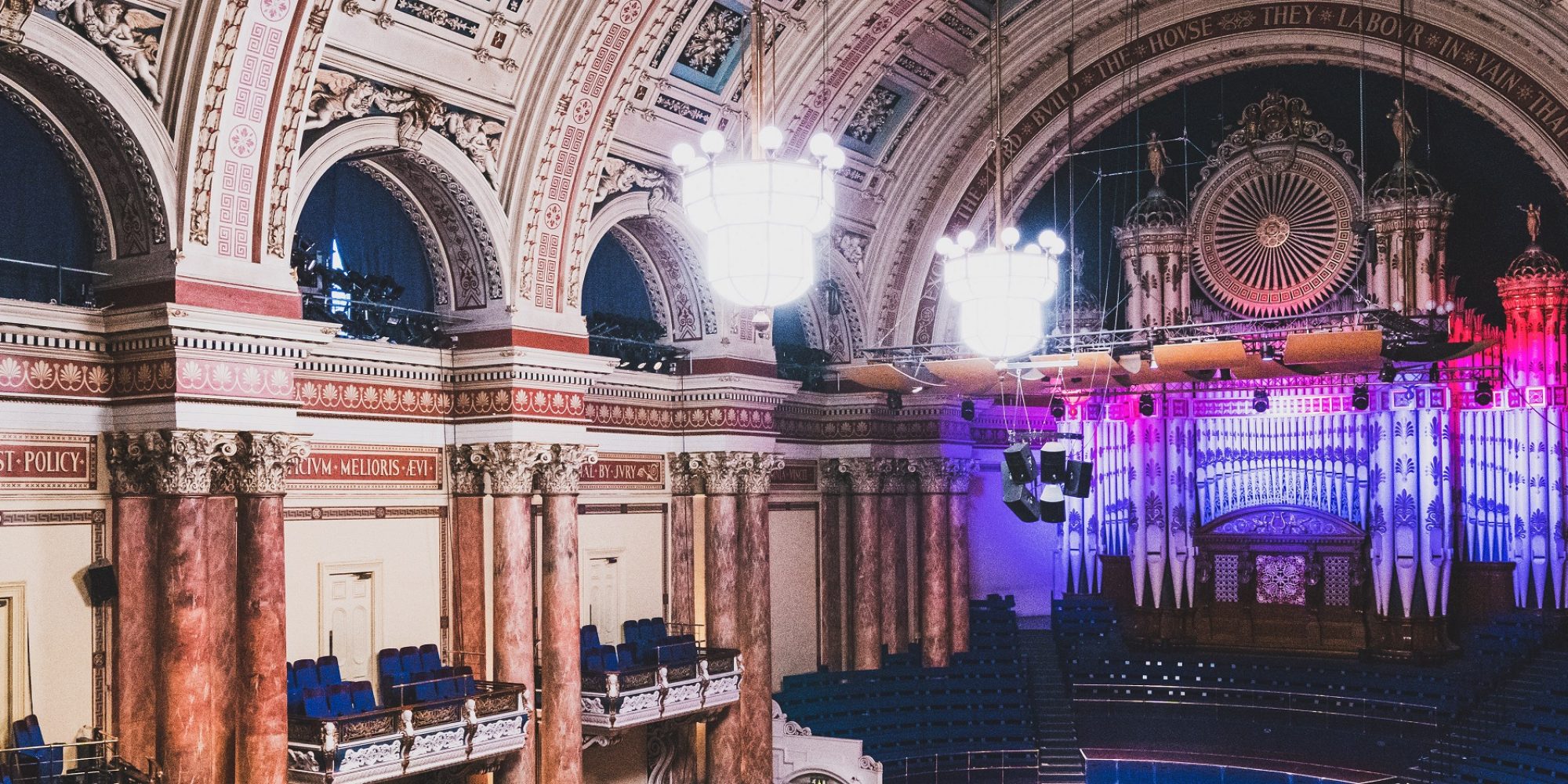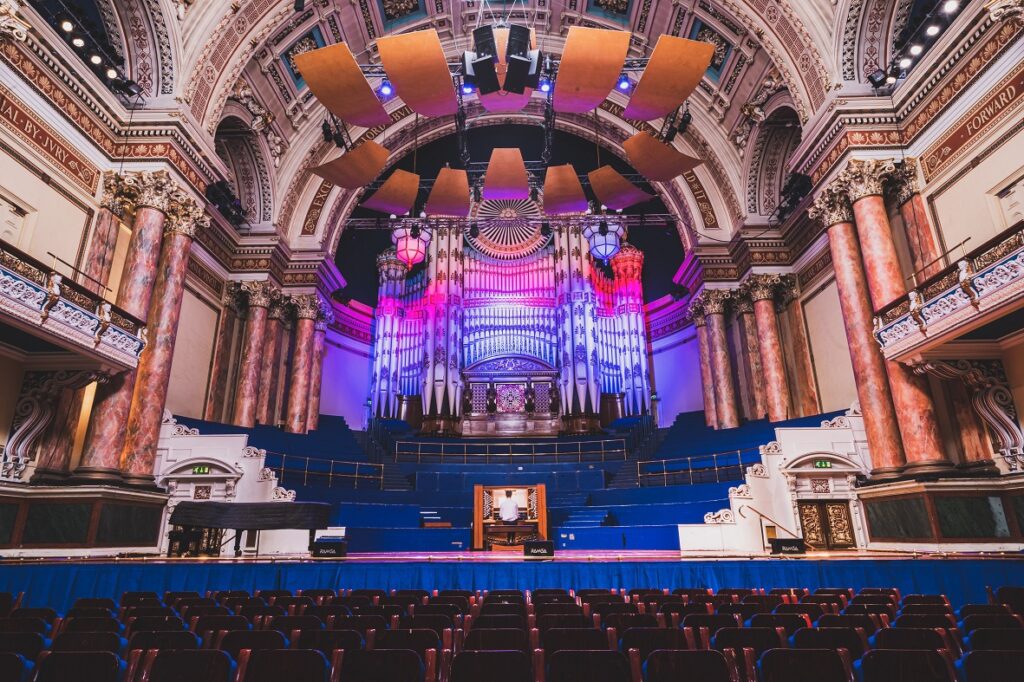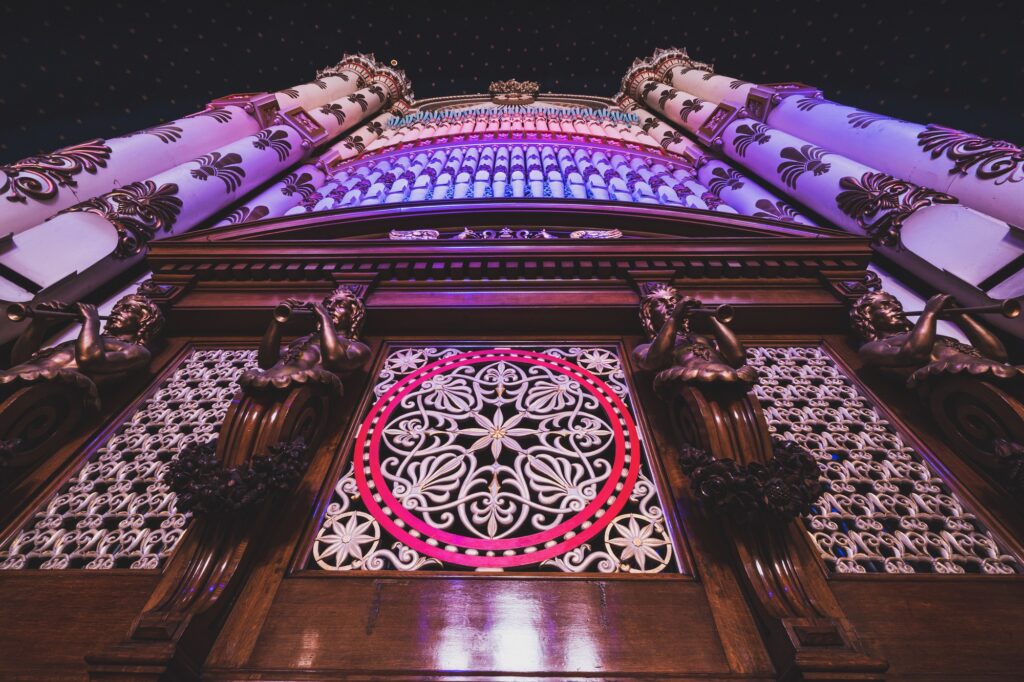

History of Leeds Town Hall organ
This magnificent instrument was originally built by Gray and Davison of London to William Spark and Henry Smart’s ambitious design of nearly 100 stops with many technical innovations. The organ was first played publicly when the building was opened in 1858 by Queen Victoria but the instrument was not completely finished until the following year.
The Leeds Town Hall organ is one of the finest and largest instruments of its kind in Europe. Measuring 12 metres high by 12 metres wide and weighing 40 tonnes, it has been a key part of the story of music making in the city, dominating the Victoria Hall musically and visually through countless performances, providing pleasure to hundreds of thousands of people since Leeds Town Hall opened in 1858. In recent times, every Monday between September and April, an audience of 200-400 regularly attend free organ recitals given by leading organists from this country and abroad, it is an integral part of Leeds International Concert Season and features each year in Leeds International Film Festival.
History of Leeds Town Hall organ
This magnificent instrument was originally built by Gray and Davison of London to William Spark and Henry Smart’s ambitious design of nearly 100 stops with many technical innovations. The organ was first played publicly when the building was opened in 1858 by Queen Victoria but the instrument was not completely finished until the following year.
The Leeds Town Hall organ is one of the finest and largest instruments of its kind in Europe. Measuring 12 metres high by 12 metres wide and weighing 40 tonnes, it has been a key part of the story of music making in the city, dominating the Victoria Hall musically and visually through countless performances, providing pleasure to hundreds of thousands of people since Leeds Town Hall opened in 1858. In recent times, every Monday between September and April, an audience of 200-400 regularly attend free organ recitals given by leading organists from this country and abroad, it is an integral part of Leeds International Concert Season and features each year in Leeds International Film Festival.


For more information about Leeds Town Hall organ, please visit the below website:
Leeds Town Hall
The Headrow
Leeds
LS1 3AD

Privacy Overview
| Cookie | Duration | Description |
|---|---|---|
| cookielawinfo-checkbox-advertisement | 1 year | Set by the GDPR Cookie Consent plugin, this cookie is used to record the user consent for the cookies in the "Advertisement" category . |
| cookielawinfo-checkbox-analytics | 11 months | This cookie is set by GDPR Cookie Consent plugin. The cookie is used to store the user consent for the cookies in the category "Analytics". |
| cookielawinfo-checkbox-functional | 11 months | The cookie is set by GDPR cookie consent to record the user consent for the cookies in the category "Functional". |
| cookielawinfo-checkbox-necessary | 11 months | This cookie is set by GDPR Cookie Consent plugin. The cookies is used to store the user consent for the cookies in the category "Necessary". |
| cookielawinfo-checkbox-others | 11 months | This cookie is set by GDPR Cookie Consent plugin. The cookie is used to store the user consent for the cookies in the category "Other. |
| cookielawinfo-checkbox-performance | 11 months | This cookie is set by GDPR Cookie Consent plugin. The cookie is used to store the user consent for the cookies in the category "Performance". |
| CookieLawInfoConsent | 1 year | Records the default button state of the corresponding category & the status of CCPA. It works only in coordination with the primary cookie. |
| elementor | never | This cookie is used by the website's WordPress theme. It allows the website owner to implement or change the website's content in real-time. |
| viewed_cookie_policy | 11 months | The cookie is set by the GDPR Cookie Consent plugin and is used to store whether or not user has consented to the use of cookies. It does not store any personal data. |
| Cookie | Duration | Description |
|---|---|---|
| __cf_bm | 30 minutes | This cookie, set by Cloudflare, is used to support Cloudflare Bot Management. |
| Cookie | Duration | Description |
|---|---|---|
| _ga | 2 years | The _ga cookie, installed by Google Analytics, calculates visitor, session and campaign data and also keeps track of site usage for the site's analytics report. The cookie stores information anonymously and assigns a randomly generated number to recognize unique visitors. |
| _gat_UA-105684902-1 | 1 minute | A variation of the _gat cookie set by Google Analytics and Google Tag Manager to allow website owners to track visitor behaviour and measure site performance. The pattern element in the name contains the unique identity number of the account or website it relates to. |
| _gid | 1 day | Installed by Google Analytics, _gid cookie stores information on how visitors use a website, while also creating an analytics report of the website's performance. Some of the data that are collected include the number of visitors, their source, and the pages they visit anonymously. |
| CONSENT | 2 years | YouTube sets this cookie via embedded youtube-videos and registers anonymous statistical data. |
| Cookie | Duration | Description |
|---|---|---|
| _fbp | 3 months | This cookie is set by Facebook to display advertisements when either on Facebook or on a digital platform powered by Facebook advertising, after visiting the website. |
| fr | 3 months | Facebook sets this cookie to show relevant advertisements to users by tracking user behaviour across the web, on sites that have Facebook pixel or Facebook social plugin. |
| VISITOR_INFO1_LIVE | 5 months 27 days | A cookie set by YouTube to measure bandwidth that determines whether the user gets the new or old player interface. |
| YSC | session | YSC cookie is set by Youtube and is used to track the views of embedded videos on Youtube pages. |
| yt-remote-connected-devices | never | YouTube sets this cookie to store the video preferences of the user using embedded YouTube video. |
| yt-remote-device-id | never | YouTube sets this cookie to store the video preferences of the user using embedded YouTube video. |
| yt.innertube::nextId | never | This cookie, set by YouTube, registers a unique ID to store data on what videos from YouTube the user has seen. |
| yt.innertube::requests | never | This cookie, set by YouTube, registers a unique ID to store data on what videos from YouTube the user has seen. |



